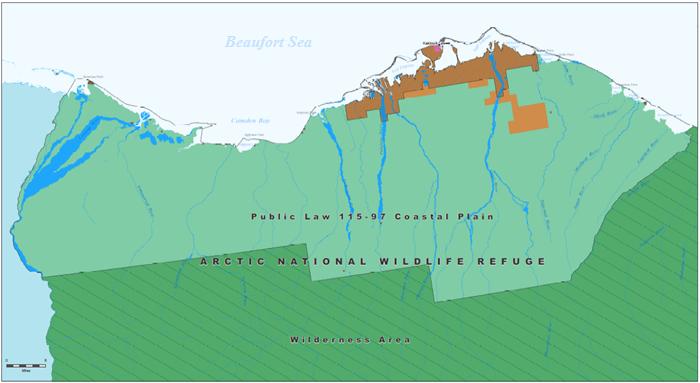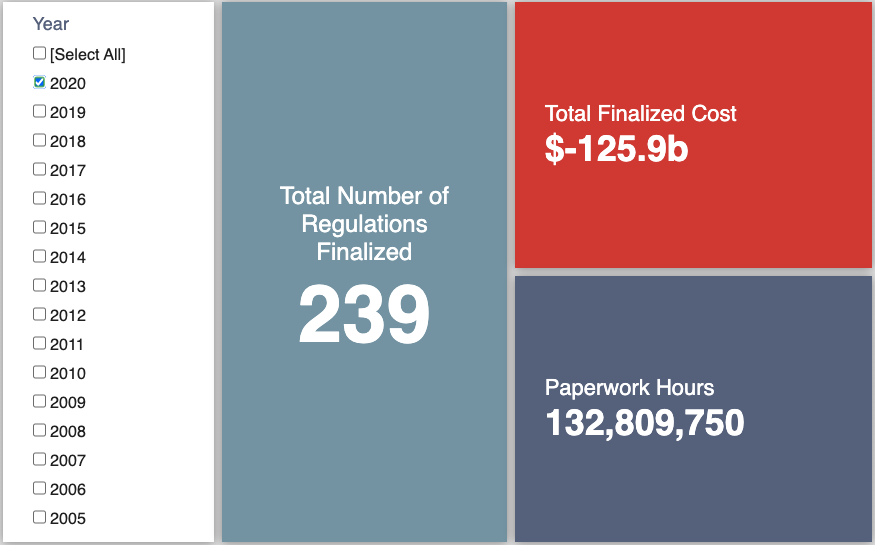Week in Regulation
August 24, 2020
Transportation Rule Leads Deregulatory Week
There were nearly a dozen actions with some measurable economic impact last week, but most were fairly mundane. In an otherwise quiet week, however, a cost-cutting measure from the Department of Transportation (DOT) left the biggest mark. The DOT rule actually builds upon one of the more notable deregulatory measures from the Obama Administration. Across all rulemakings, agencies published $673.6 million in total net cost savings and cut 673,297 hours of annual paperwork.
REGULATORY TOPLINES
- Proposed Rules: 24
- Final Rules: 78
- 2020 Total Pages: 51,954
- 2020 Final Rule Costs: -$125.9 billion
- 2020 Proposed Rule Costs: $8 billion
TRACKING THE REGULATORY BUDGET
The DOT rule regarding “Passenger Carrier No-Defect Driver Vehicle Inspection Reports” was the most consequential action with regards to the fiscal year (FY) 2020 regulatory budget. The rule “rescinds the requirement that drivers of passenger-carrying commercial motor vehicles (CMVs) operating in interstate commerce submit, and motor carriers retain, driver-vehicle inspection reports (DVIRs) when the driver has neither found nor been made aware of any vehicle defects or deficiencies.” DOT estimates that removing this requirement could yield roughly $770 million in present value savings.
The rule is in a similar vein to a 2014 rule rescinding such a requirement for non-passenger-carrying CMVs. That rule was significant because it was one of the most striking deregulatory measures during the Obama era. DOT maintained the no-defect DVIR requirement for passenger vehicles in that rule, contending at the time that the potential consequences of human injury in traffic incidents was on a different level than those of damaged freight. DOT now extends this policy to passenger vehicles, finding “no information to suggest that preparation, submission, and review of no-defect DVIRs produce a greater level of safety than that of a defect-based approach,” and specifically cites the lack of any adverse incidents since the 2014 rule.
The Trump Administration expected to reach $51.6 billion in cumulative net savings in FY 2020. To date in the fiscal year, agencies have officially published 120 deregulatory actions and 42 regulatory actions, totaling $170.7 billion in quantified total net cost savings.
THIS WEEK’S REGULATORY PICTURE
This week, the Department of Interior (DOI) makes a final determination regarding potential oil and gas operations in the Arctic National Wildlife Refuge (ANWR).
Source: https://www.blm.gov/programs/energy-and-minerals/oil-and-gas/about/alaska/coastal-plain-arctic-national-wildlife-refuge
ANWR is an area in the northern part of Alaska that has served as an archetype for public-lands debates for decades now. The area in particular question is the “Coastal Plain,” a roughly 1.6 million square-mile area that could possibly contain nearly 12 billion barrels of oil. Acting upon a provision in the 2017 Tax Cuts and Jobs Act (TCJA), Interior Secretary David Bernhardt took action this past week to further solidify the Coastal Plain’s legal designation as an area open to further drilling and extraction development.
The Alaska National Interest Lands Conservation Act (ANILCA) created the modern parameters of ANWR and allowed for limited study of the potential resources in the “Coastal Plain,” but it also prohibited the drilling development in ANWR writ large without proper congressional authorization. The relevant portions of the TCJA removed this prohibition for the “Coastal Plain” and included affirmative directives to DOI to promote development in this area. Last week’s Record of Decision (ROD) represents the administrative action that makes further development possible.
The ROD opens up the colored areas pictured in the above map to leases for oil and gas operations. While there is a great degree of uncertainty regarding how these potential operations take shape individually – they do still need to undergo other typical environmental reviews – but this action clears a major legal hurdle for even the idea of these operations. Litigation and the political disputes over the decision are sure to follow and very well may throw it into dispute, but for the time being (and for the first time in roughly 40 years) there’s a clear answer on the question of general development in ANWR.
TOTAL BURDENS
Since January 1, the federal government has published $117.9 billion in total net cost savings (with $125.9 billion from finalized rules) and 152 million hours of net annual paperwork burden increases (with 132.8 million hours due to final rules). Click here for the latest Reg Rodeo findings.












